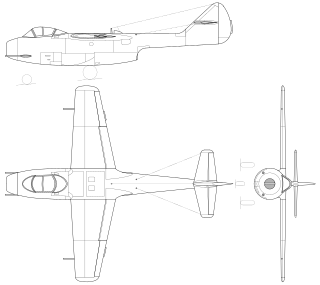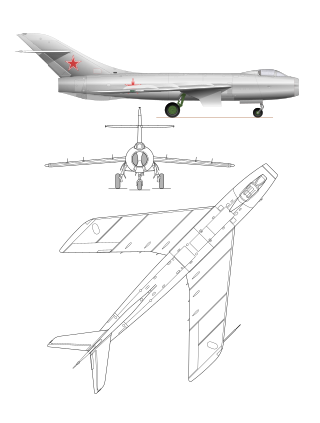
The Mikoyan-Gurevich MiG-9 was the first turbojet fighter developed by Mikoyan-Gurevich in the years immediately after World War II. It used reverse-engineered German BMW 003 engines. Categorized as a first-generation jet fighter, it suffered from persistent problems with engine flameouts when firing its guns at high altitudes due to gun gas ingestion. A number of different armament configurations were tested, but none solved the problem. Several different engines were evaluated, but none were flown, as the prototype of the MiG-15 promised superior performance.

The Henschel Hs 132 was a World War II dive bomber and interceptor aircraft of the German Luftwaffe that never saw service. The unorthodox design featured a top-mounted BMW 003 jet engine and the pilot in a prone position. The Soviet Army occupied the factory just as the Hs 132 V1 was nearing flight testing, the V2 and V3 being 80% and 75% completed.

The Mikoyan-Gurevich I-270 was a response to a Soviet Air Forces requirement in 1945 for a rocket-powered interceptor aircraft for the point-defence role. In concept and basic configuration, it was related to the early Korolyov RP-318 rocket-powered aircraft which was developed in 1936 and first flew February 20, 1940, and the more recent Bereznyak-Isayev BI-1 Soviet design. Only two prototypes were built, both of which were destroyed in crashes, leading to the cancellation of the project.

The CASA C-101 Aviojet is a low-wing single engine jet-powered advanced trainer and light attack aircraft designed and manufactured by Spanish aircraft company Construcciones Aeronáuticas SA (CASA).

The PZL TS-11 Iskra is a Polish jet trainer, developed and manufactured by aircraft company PZL-Mielec. It was used by the air forces of Poland and India. It is notable as being the first domestically developed jet aircraft to be produced by Poland, its service for over 50 years as the principal training aircraft of the Polish Air Force, and at the time of its retirement was the oldest jet-propelled aircraft still in service in Poland.

The PZL TS-8 Bies (Devil) is a Polish trainer aircraft, used from 1957 to the 1970s by the Polish Air Force and civilian aviation.

The Sukhoi Su-9 was an early jet fighter built in the Soviet Union shortly after World War II. The design began in 1944 and was intended to use Soviet-designed turbojet engines. The design was heavily influenced by captured German jet fighters and it was subsequently redesigned to use a Soviet copy of a German turbojet. The Su-9 was slower than competing Soviet aircraft and it was cancelled as a result. A modified version with different engines and a revised wing became the Su-11, but this did not enter production either. The Su-13 was a proposal to re-engine the aircraft with Soviet copies of the Rolls-Royce Derwent turbojet as well as to modify it for night fighting, but neither proposal was accepted.

The Yakovlev Yak-15 was a first-generation Soviet turbojet fighter developed by the Yakovlev design bureau (OKB) immediately after World War II. The main fuselage was that of Yakovlev Yak-3 piston-engine fighter modified to mount a reverse-engineered German Junkers Jumo 004 engine. The Yak-15 and the Swedish Saab 21R were the only two jets to be successfully converted from piston-power to enter production. 280 aircraft were built in 1947. Although nominally a fighter, it was mainly used to qualify piston-engine-experienced pilots to fly jets.

The PZL 130 Orlik is a Polish turboprop, single engine, two seat trainer aircraft.

The Temco TT Pinto is a tandem two-seat primary jet trainer built for the United States Navy by Temco Aircraft of Dallas, Texas.

The Lavochkin La-150, was designed by the Lavochkin design bureau (OKB) in response to a 1945 order to build a single-seat jet fighter using a single German turbojet. By this time both the Americans and British, as well as the Germans, had already flown jet fighters and the single Soviet jet engine under development was not yet ready for production. The design was completed quickly, but the construction of the five flying prototypes was protracted by the factory's inexperience in building metal aircraft. The aircraft made its first flight in September 1946, but proved to require extensive modifications to meet the Soviet Air Forces' requirements. These took so long to make and test that the aircraft was essentially obsolete by the time that they were completed. Even one variant with a much more powerful engine was inferior to other aircraft that the OKB had under development and all work was terminated in 1947.

The Sukhoi Su-6 was a Soviet ground-attack aircraft developed during World War II. The mixed-power high-altitude interceptor Su-7 was based on the single-seat Su-6 prototype.

The Sukhoi Su-17 was a prototype Soviet fighter. The name was later reused for an entirely different fighter-bomber, see Sukhoi Su-17.

The Yakovlev Yak-30, originally designated Yakovlev 104, was Yakovlev's entry in a competition for the first military jet trainer aircraft designed for Warsaw Pact nations. Designed to succeed the Yak-17UTI, it also led to the development of the Yakovlev Yak-32 sport jet. The Yak-30 lost to the L-29 Delfin, and neither it nor the Yak-32 entered production.

The PZL-105 Flaming (flamingo) is a Polish short-takeoff-and-landing (STOL) utility aircraft designed by PZL "Warszawa-Okęcie". It remained a prototype.

The MD-12 is a Polish four-engined short-range passenger and civil utility aircraft of the 1960s, which remained in the prototype stage. The PZL brand is conventional, since it did not enter production, and was referred to under its project designation only.

The Ikarus 451 is a family of research aircraft designs built in Yugoslavia in the 1950s, all sharing the same basic airframe, but differing in powerplants and cockpit arrangements. One member of the family Ikarus 451M became the first domestically-built jet aircraft to fly in Yugoslavia, on 25 October 1952.

The Promavia F.1300 Jet Squalus, also known as Promavia Jet Squalus F1300, was a two-seat light jet trainer designed by Italian Stelio Frati and built by Promavia in Belgium with support from the Belgian government.

The Lavochkin La-152,, and its variants, was a jet fighter prototype designed and manufactured by the Lavochkin Design Bureau (OKB) shortly after the end of World War II. Derived from the Lavochkin La-150, the 152 used several different engines, but the program was canceled as other fighters with more powerful engines and swept wings showed more promise.
The EADS PZL PZL-112 Junior is a Polish single engine, two-seat trainer built by PZL Warszawa-Okecie.


















